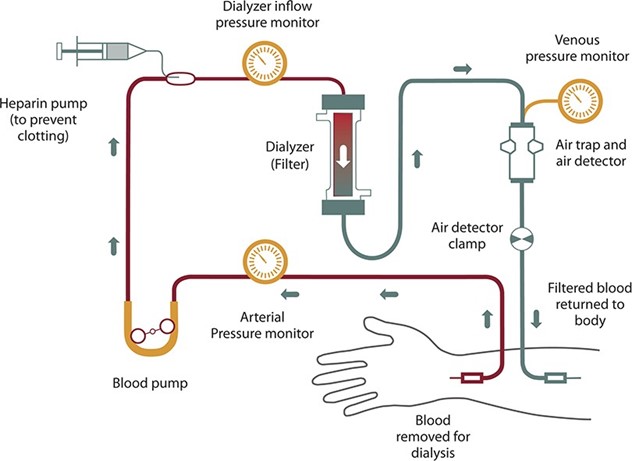A nurse is reviewing the laboratory data of a client following a hemodialysis treatment. The nurse should expect to find a decrease in which of the following laboratory values?
Calcium
Potassium
Protein
RBC count
The Correct Answer is B
Choice a) is incorrect because calcium levels are not directly affected by hemodialysis. Calcium is a mineral that is important for bone health, blood clotting, and muscle contraction. Hemodialysis does not remove calcium from the blood, but it may cause low calcium levels if the dialysate fluid has a lower concentration of calcium than the blood.
Choice b) is correct because potassium levels are decreased by hemodialysis. Potassium is an electrolyte that is essential for nerve and muscle function, especially the heart. Hemodialysis removes excess potassium from the blood, which can build up in people with kidney failure and cause irregular heartbeats, muscle weakness, or even cardiac arrest.
Choice c) is incorrect because protein levels are not decreased by hemodialysis. Protein is a macromolecule that is composed of amino acids and performs various functions in the body, such as building and repairing tissues, transporting substances, and regulating processes. Hemodialysis does not remove protein from the blood, but it may cause low protein levels if the client has a poor diet or loses protein through other means, such as urine or wounds.
Choice d) is incorrect because RBC count is not decreased by hemodialysis. RBCs are red blood cells that carry oxygen throughout the body. Hemodialysis does not remove RBCs from the blood, but it may cause low RBC count if the client has anemia, which is a common complication of kidney failure. Anemia can be caused by reduced production of erythropoietin (a hormone that stimulates RBC production), iron deficiency, or blood loss.

Nursing Test Bank
Naxlex Comprehensive Predictor Exams
Related Questions
Correct Answer is ["A","C","D","F"]
Explanation
Choice A: A cervical spinal cord injury can impair the function of cranial nerves, leading to a weakened gag reflex and an increased risk of aspiration.
Choice B:Patients with spinal cord injuries are more likely to experience poikilothermia (difficulty regulating body temperature), but this often results in hypothermia, not hyperthermia, due to the loss of autonomic temperature control.
Choice C:Spinal shock, which often follows a spinal cord injury, can cause decreased or absent bowel sounds due to a temporary loss of autonomic function and decreased peristalsis.
Choice D:Depending on the level and severity of the injury, paralysis can occur, affecting motor function below the injury site. A cervical spinal cord injury may lead to quadriplegia (tetraplegia).
Choice E:Clients with spinal cord injuries are more likely to experience urinary retention, rather than polyuria, due to loss of bladder control and autonomic dysfunction. A foley catheter may be needed initially, followed by intermittent catheterization.
Choice F:Neurogenic shock, a potential complication of cervical spinal cord injuries, can cause hypotension due to the loss of sympathetic nervous system control over blood vessel tone, leading to vasodilation and bradycardia.
Correct Answer is B
Explanation
Choice A Reason: This is incorrect because a decreased level of consciousness is a late sign of shock, not an early one. Decreased level of consciousness indicates that the brain is not receiving enough oxygen and blood flow, which can lead to irreversible damage and death.
Choice B Reason: This is correct because increased respiratory rate is an early sign of shock, indicating hypoxia. This finding indicates that the client is experiencing hypoxia, which is a lack of oxygen in the tissues and organs. Hypoxia is a common and early sign of shock, which is a condition where the body's vital organs do not receive enough blood
flow and oxygen due to low blood pressure, low cardiac output, or low blood volume. The client's respiratory rate increases as a compensatory mechanism to increase oxygen intake and delivery.
Choice C Reason: This is incorrect because hypotension is a late sign of shock, not an early one. Hypotension indicates that the blood pressure is too low to maintain adequate perfusion and oxygenation to the vital organs.
Choice D Reason: This is incorrect because anuria is a late sign of shock, not an early one. Anuria indicates that the kidneys are not receiving enough blood flow and oxygen, which can result in acute kidney injury or failure.
Whether you are a student looking to ace your exams or a practicing nurse seeking to enhance your expertise , our nursing education contents will empower you with the confidence and competence to make a difference in the lives of patients and become a respected leader in the healthcare field.
Visit Naxlex, invest in your future and unlock endless possibilities with our unparalleled nursing education contents today
Report Wrong Answer on the Current Question
Do you disagree with the answer? If yes, what is your expected answer? Explain.
Kindly be descriptive with the issue you are facing.
